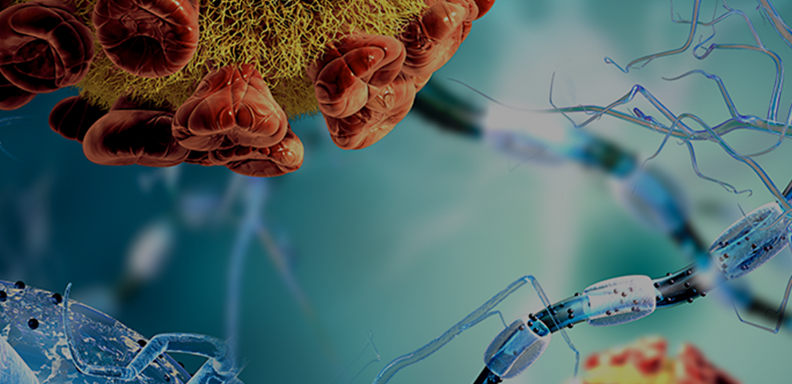By
Matt Wood
Director of Communications, Biological Sciences Division
Humans have trillions of bacteria in their intestines, but it wasn’t until about 15 years ago that the larger scientific community became very interested in these communities of organisms and how they impact human health and disease. “One of the many fascinating aspects of the bacteria in and on our bodies is that we all have some bacteria that are unique to us that no one else has,” said Laurie Comstock, PhD. “Our bacteria are modified by our other bacterial members to become personalized.”
Comstock, a Professor of Microbiology in the Duchossois Family Institute (DFI) at the University of Chicago, has spent her career studying an abundant order of bacteria that live in the human gut, the Bacteroidales. Researchers have come to understand that these microbes have a profound impact on our health, from shaping our metabolism and susceptibility to diseases to how we respond to medical treatments. The bacteria and other microbes living in our intestines cooperate to synthesize and break down essential nutrients. The Bacteroidales, for example, produce a variety of enzymes that help break down plant polysaccharides from fruits and vegetables that humans can’t digest. They provide numerous other benefits to us, and we provide them a nice, cozy place to live. It’s a mutually beneficial relationship, but how did that evolve? What affects a strain of bacteria’s ability to survive in the gut? And how does it cooperate or compete with other bacteria around it?
“We know a lot about E. coli and pathogens that can make us sick, but we’re still learning about the bacteria that live in our intestines,” Comstock said. “We are just learning how these microbial communities are formed and how they’re stabilized. We’re interested in those ecological questions and what microbial factors contribute to alterations in the community.”
Mobile genetic elements to acquire new traits
Comstock joined UChicago in the fall of 2021 after more than 25 years at Harvard Medical School and Brigham and Women’s Hospital studying Bacteroidales. During the early stages of her career, she focused on the pathogenic properties of Bacteroides fragilis, which can cause infection if they escape into the bloodstream from the intestine. She later shifted to studying this organism and other closely related Bacteroidales as mutualistic members of the gut microbiota. She says she found the myriad mechanisms these bacteria use to thrive in the intestine far more interesting.
“Causing disease is a dead end for the organism,” Comstock said. “The properties we were studying that allow them to survive in the intestine are just so fascinating. The biology of these bacteria is quite different to what had been described, so everything we were studying was something new that hadn’t been described before in bacteria.”
One fascinating aspect of these bacteria is their extensive horizontal gene transfer, or the ability to exchange DNA with each other. This happens as bacteria make contact and often leads to the acquisition of new traits and functions.
“Many groups, including ours, have performed bioinformatic analyses to determine what DNA is moving around by comparing the genomes, but the hard part is figuring out what properties those mobile elements confer to the receiving organism,” she said. Her group is actively studying the properties conferred by these genetic elements and what benefits they may provide.
Comstock’s lab is also interested in how the Bacteroidales compete for nutrients and space. Her lab has identified several antibacterial toxins that these bacteria use to antagonize each other, a form of bacterial warfare that contributes to shaping the composition of the microbial community. These toxins target other closely related bacteria that will likely compete for the same nutrients. For these studies, her team will often start by identifying a microbe that produces a relatively powerful toxin that is good at killing other microbes, and then do genetic analysis to identify the gene that produces it. Then, they study the target cells to identify the receptor and the toxin’s lethal mechanism . In some cases, they might see that a particular cell is resistant to the toxin, so they study how it protects itself as well.
Using this mechanistic understanding of how bacteria produce a toxin and how that toxin affects other microbes around it, they can then look for the same activity from these bacteria in mouse models. Sometimes those results hold true, but sometimes the effects are less drastic than in petri dishes. The sensitive cells may be able to protect themselves in certain niches in this the gut, or the toxin may only have an effect when the cells are nearby.
In addition to the mouse model, they analyze metagenomic datasets from the human gut to see if strains that are sensitive to the toxin can coexist in the same community with strains that produce the toxin. In some cases, there are significant exclusions, meaning that if a microbe for making a certain toxin is present in the gut, the one sensitive to it is significantly underrepresented. That toxin, and the genes responsible for it, affect the ecology of the gut microbiome, and could provide clues about which microbes can be the most successful, what benefits they can provide, or how they may be sensitive to disruptions from invaders.
Translating discoveries into treatments
In addition to studying the ecology of these interactions, her lab is looking to translate these discoveries. These antimicrobial molecules could be used to treat infections. For example, all four species of Prevotella that are associated with vaginal infections are sensitive to one of the toxins discovered in Comstock’s lab. Her team is currently performing collaborative preclinical studies to see if this antimicrobial molecule can help treat recurrent infections.
Another use could be to add these toxin genes to beneficial probiotic type bacteria to help them become established in an ecosystem. You’ve probably seen probiotic supplements that claim to contain bacteria that can help with digestion and gut health, but most of these products just pass through the system because they don’t have the ability to compete with established members of the gut microbiome. Adding in some of these antimicrobial toxin genes could give a modified strain the edge it needs to engraft and deliver some benefits along with your probiotic smoothie.
There is still so much more to learn from bacteria like Bacteroidales that colonize at high density in the human gut. We need them as much as they need us, and for Comstock, this relationship is endlessly fascinating.
“Our studies are always leading us in new directions. Everywhere we look, there’s new and interesting biology,” she said. “I got a love for studying bacteria in college. I took a few classes and was hooked, and I’m still fascinated by them today.”



